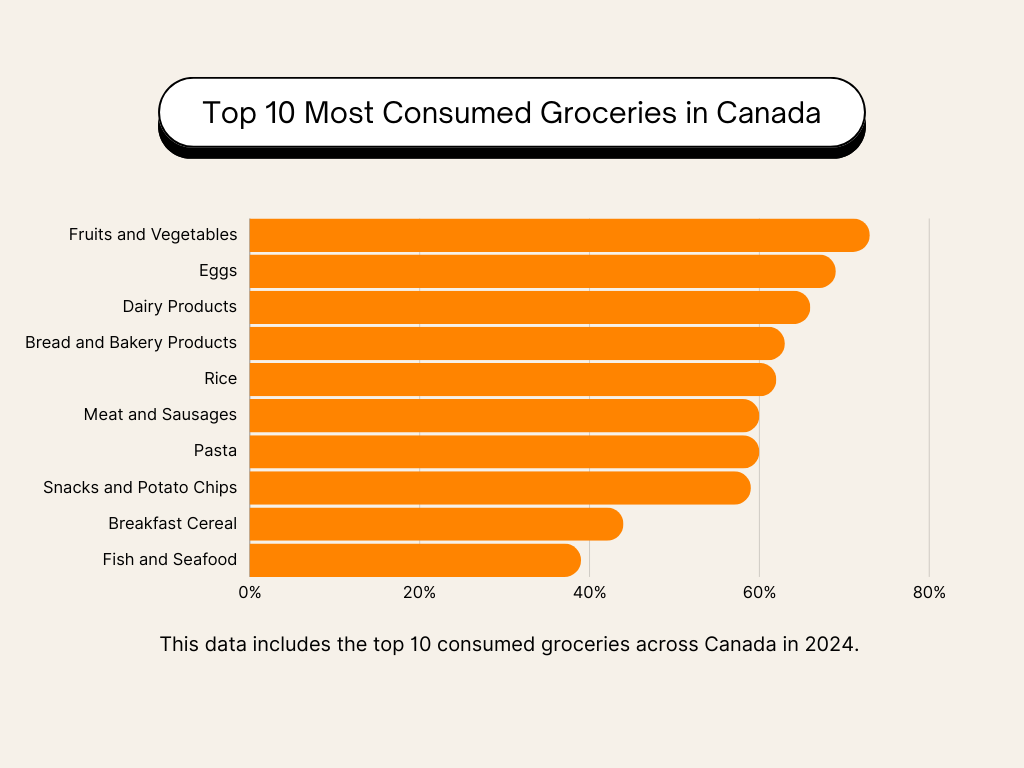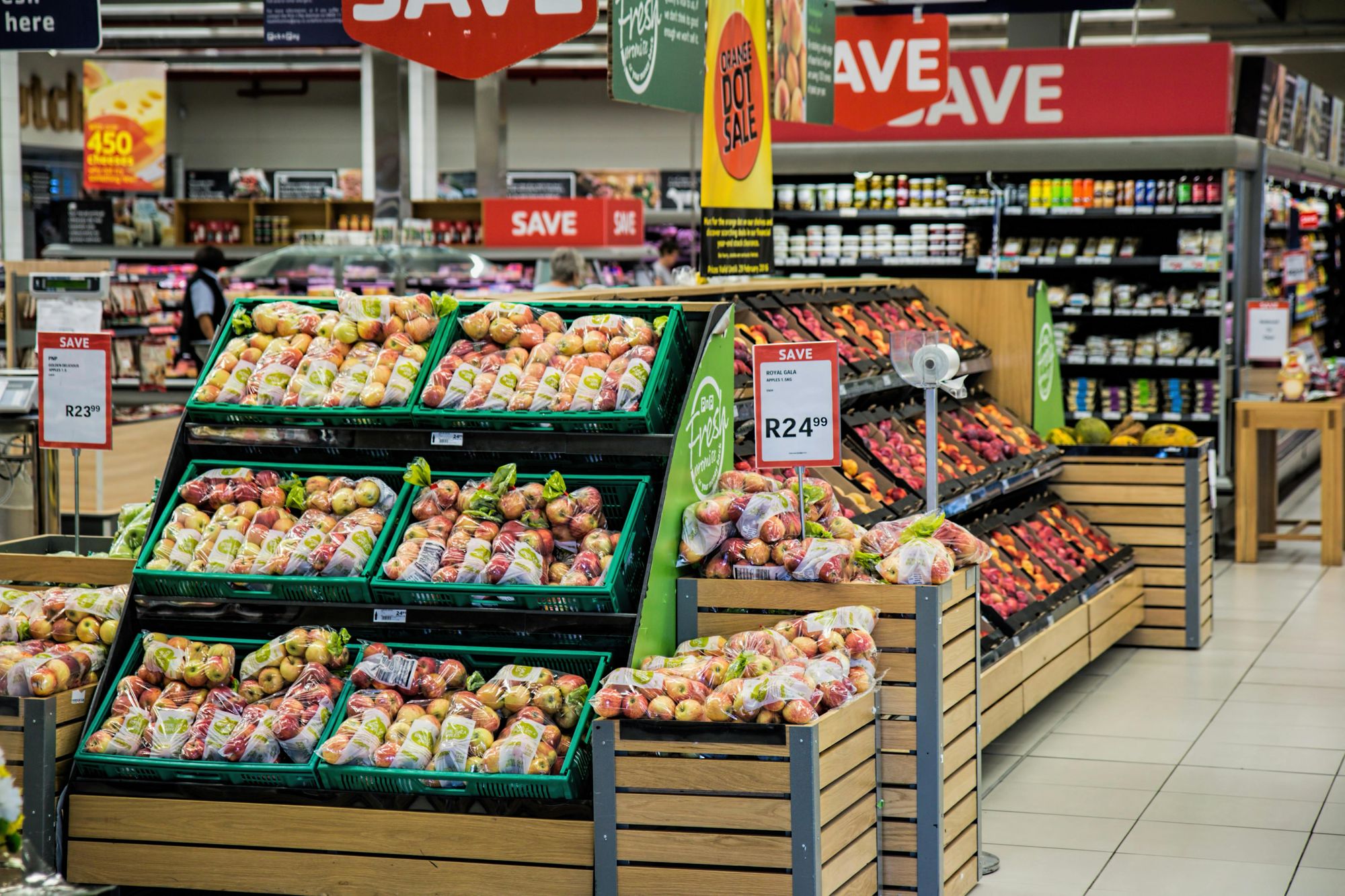Canada's grocery market is witnessing significant changes as consumers face rising costs. Understanding which food categories are most consumed can offer insights into how price increases impact Canadians. Based on recent data, fruits and vegetables, eggs, and dairy products lead the list of the most consumed grocery items. Here’s a breakdown of the top 10 most consumed grocery products in Canada, along with an analysis of how these consumption trends might shift in response to rising prices.
Top 10 Most Consumed Groceries in Canada
| Grocery Item | Percentage of Consumption (%) |
|---|---|
| Fruits and Vegetables | 73% |
| Eggs | 69% |
| Dairy Products | 66% |
| Bread and Bakery Products | 63% |
| Rice | 62% |
| Meat and Sausages | 60% |
| Pasta | 60% |
| Snack and Potato Chips | 59% |
| Breakfast Cereal | 44% |
| Fish and Seafood | 39% |

Source: Statista
Analysis of Grocery Consumption Trends in Canada
Fruits and vegetables, consumed by 73% of Canadians, remain at the top of the list. This high consumption rate reflects a growing trend toward healthier eating habits, but these items are also highly susceptible to price fluctuations, especially as weather patterns and supply chain issues affect availability. With increasing prices, consumers may start to substitute fresh produce with frozen or canned alternatives, which could alter long-term purchasing behavior.
Eggs (69%) and dairy products (66%) are also core staples in the Canadian diet. These are highly sensitive to inflation as they are often linked to fluctuating feed and transportation costs. Increased prices may prompt consumers to explore plant-based alternatives, a trend already gaining momentum in Canada.
Bread, rice, and pasta (63%, 62%, and 60% respectively) reflect the importance of affordable, carbohydrate-rich foods in the Canadian diet. As prices for these staples rise, low-income households may be particularly affected, potentially turning to cheaper alternatives or smaller quantities.
Meat, sausages, and fish, consumed by 60% and 39% of Canadians respectively, may see the most noticeable decline in consumption. Rising meat prices, driven by supply chain challenges, environmental factors, and inflation, could lead consumers to cut down on portions or switch to plant-based protein sources.
Average Monthly Grocery Costs for Canadians
Single Adults
The cost of food for one person in Canada varies based on age and gender. According to Canada’s Food Price Report 2023:
- Men aged 31–50: Spend approximately $347 per month on groceries.
- Women aged 31–50: Spend slightly less, around $311 per month.
These figures reflect typical grocery spending for home-cooked meals and exclude eating out or specialty diet costs.
Couples Without Children
Couples without kids generally spend between $600 and $800 per month, combining their grocery purchases. While they benefit from buying in bulk, individual preferences and dietary needs can still drive up costs.
Families with Children
For families, grocery bills rise significantly:
- Family of Four: A family with two parents, a teenage son, and a younger daughter spends about $1,357.36 per month, or $16,288.41 annually.
- Single Parents: Grocery expenses for single-parent households depend on the number and ages of children but generally range between $800 and $1,200 per month.
These estimates focus on home-cooked meals and don’t account for food delivery, takeout, or specialized diets.
Food prices in Canada by Province
Let us understand how food prices differ in Canada by looking at each of the provinces.
Grocery prices in Newfoundland and Labrador
In Newfoundland and Labrador, food prices have seen notable increases from 2017 to 2024.
Fruits and vegetables rose from $3.73 to $4.89, reflecting high transportation costs and inflationary pressures in remote regions.
Egg prices surged from $3.44 to $5.04, marking one of the highest growth rates in the country.
Dairy products also saw a significant rise, with prices climbing from $4.08 to $5.15, driven by importation challenges.
Bread and bakery products increased from $3.29 to $3.98, and rice prices went up from $7.08 to $7.75.
Meat and sausages experienced a substantial jump from $9.85 to $13.46, while pasta prices rose from $2.23 to $3.24, with the most noticeable increases occurring in the past two years.
Snacks and potato chips rose from $2.31 in 2017 to $3.00 in 2024, marking a 30% increase, with prices peaking at $3.10 in 2023 and spiking sharply between 2020 and 2023.
Breakfast cereals increased from $3.39 in 2017 to $4.37 in 2024, reflecting a 28.9% rise, with significant increases occurring between 2021 and 2023.
Fish and seafood prices grew from $13.70 in 2017 to $16.89 in 2024, a 23.3% increase, with the most substantial price hikes occurring between 2021 and 2023.
Food prices in Newfoundland and Labrador
| Food Item | 2017 | 2024 | % Difference |
|---|---|---|---|
| Fruits and Vegetables | $3.73 | $4.89 | 31% |
| Eggs | $3.44 | $5.04 | 47% |
| Dairy Products | $4.08 | $5.15 | 26% |
| Bread and Bakery | $3.29 | $3.98 | 21% |
| Rice | $7.08 | $7.75 | 9% |
| Meat and Sausages | $9.85 | $13.46 | 37% |
| Pasta | $2.23 | $3.24 | 45% |
| Snacks and Potato Chips | $2.31 | $3.00 | 30% |
| Breakfast Cereals | $3.39 | $4.37 | 29% |
| Fish and Seafood | $13.70 | $16.89 | 23% |

Grocery prices in British Columbia
In British Columbia, food prices have generally trended upwards from 2017 to 2024.
Fruits and vegetables rose from $3.13 to $4.42, influenced by high demand and logistical costs.
Egg prices increased significantly from $3.86 to $5.26, with sharp rises post-2021. Dairy prices grew from $4.03 to $5.11, reflecting inflation and transportation issues.
Bread and bakery products saw a steady increase from $3.00 to $3.62.
Rice prices climbed from $5.81 to $7.58, with the largest increases observed in the past few years.
Meat and sausages prices rose from $10.50 to $14.37, while pasta prices went up from $2.62 to $3.34, reflecting a trend towards higher grocery costs.
Food Prices in British Columbia
| Food Item | 2017 | 2024 | Percentage Change |
|---|---|---|---|
| Fruits and Vegetables | $3.13 | $4.42 | 41% |
| Eggs | $3.86 | $5.26 | 36% |
| Dairy Products | $4.03 | $5.11 | 27% |
| Bread and Bakery products | $3.00 | $3.62 | 21% |
| Rice | $5.81 | $7.58 | 30% |
| Meats and Sausage | $10.50 | $14.36 | 37% |
| Pasta | $2.62 | $3.34 | 27% |
| Snacks and Potato Chips | $2.37 | $2.85 | 20% |
| Breakfast cereal | $3.23 | $4.20 | 30% |
| Fish and seafood | $15.46 | $17.80 | 15% |
The price of snacks and potato chips increased from $2.37 in 2017 to $2.85 in 2024, reflecting a 20% rise, with the most significant increase between 2021 and 2023 due to rising production and transportation costs.
Breakfast cereal prices grew from $3.23 in 2017 to $4.20 in 2024, marking a 30% increase, with the largest jump occurring between 2021 and 2023.
Fish and seafood prices rose from $15.46 in 2017 to $17.80 in 2024, a 15.1% increase, showing a steady rise especially between 2021 and 2022 due to inflation and supply chain issues.
Grocery prices in Ontario
Ontario experienced a steady rise in food prices between 2017 and 2024.
Fruits and vegetables increased from $2.73 to $3.70, despite the province being a major agricultural hub.
Egg prices rose from $2.82 to $4.67, reflecting inflation and supply chain challenges.
Dairy prices grew from $3.97 to $5.31, with the province seeing some of the highest increases.
Bread prices went up from $2.42 to $3.10, with a noticeable jump post-2022.
Rice prices rose from $5.28 to $6.72, and meat and sausages saw an increase from $9.92 to $12.54.
Pasta prices increased from $2.37 to $3.12, with significant price hikes in recent years.
The price of snacks and potato chips rose from $2.28 in 2017 to $2.75 in 2024, a 21% increase, with notable price jumps between 2021 and 2023 driven by production costs and inflation.
Breakfast cereals experienced a significant 37.6% increase, growing from $3.03 in 2017 to $4.17 in 2024, with the sharpest hikes occurring between 2021 and 2023.
Fish and seafood prices rose from $15.50 in 2017 to $17.31 in 2024, reflecting an 11.7% increase, with a significant jump between 2021 and 2022.
Food prices in Ontario
| Food Item | 2017 | 2024 | % Difference |
|---|---|---|---|
| Fruits and Vegetables | $2.73 | $3.70 | 36% |
| Eggs | $2.82 | $4.67 | 66% |
| Dairy Products | $3.97 | $5.31 | 34% |
| Bread and Bakery | $2.42 | $3.10 | 28% |
| Rice | $5.28 | $6.72 | 27% |
| Meat and Sausages | $9.92 | $12.54 | 26% |
| Pasta | $2.37 | $3.12 | 32% |
| Snacks and Potato Chips | $2.28 | $2.75 | 21% |
| Breakfast Cereals | $3.03 | $4.17 | 38% |
| Fish and Seafood | $15.50 | $17.31 | 12% |
Grocery prices in Quebec
Quebec saw consistent increases in food prices from 2017 to 2024.
Fruits and vegetables grew from $2.84 to $3.76, with noticeable rises post-2021.
Egg prices increased from $2.91 to $3.80, showing more modest growth compared to other provinces.
Dairy prices rose from $4.22 to $5.23, slightly above the national average.
Bread prices went up from $2.67 to $3.64, with significant increases after 2021. Rice prices climbed from $5.98 to $7.58, reflecting broader inflation trends.
Meat and sausages prices increased from $10.93 to $13.16, while pasta prices rose from $2.25 to $3.15, reflecting a trend of rising grocery costs.
Snacks and potato chips increased from $2.55 in 2017 to $2.80 in 2024, a 10% rise, with moderate fluctuations and a steady increase post-2021.
Breakfast cereal prices rose from $3.24 in 2017 to $4.19 in 2024, reflecting a 29.3% increase, with the largest surge occurring between 2021 and 2023.
Fish and seafood prices grew from $14.76 in 2017 to $17.14 in 2024, showing a 16.1% increase, with the most significant price jump occurring between 2021 and 2023.
Food prices in Quebec
| Food Item | 2017 | 2024 | % Difference |
|---|---|---|---|
| Fruits and Vegetables | $2.84 | $3.76 | 32% |
| Eggs | $2.91 | $3.80 | 31% |
| Dairy Products | $4.22 | $5.23 | 24% |
| Bread and Bakery | $2.67 | $3.64 | 36% |
| Rice | $5.98 | $7.58 | 27% |
| Meat and Sausages | $10.93 | $13.16 | 20% |
| Pasta | $2.25 | $3.15 | 40% |
| Snacks and Potato Chips | $2.55 | $2.80 | 10% |
| Breakfast Cereals | $3.24 | $4.19 | 29% |
| Fish and Seafood | $14.76 | $17.14 | 16% |
Grocery prices in Alberta
In Alberta, food prices have risen notably from 2017 to 2024.
Fruits and vegetables increased from $3.10 to $4.39, following national trends. Egg prices rose from $3.53 to $4.87, with steep increases after 2021 due to rising feed costs.
Dairy prices grew from $4.00 to $5.10, with a significant rise post-2021.
Bread prices increased from $3.08 to $3.56, with a sharp rise observed in the past few years.
Rice prices rose from $5.76 to $7.32, reflecting economic disruptions during the pandemic.
Meat and sausages saw a price increase from $10.55 to $13.99, and pasta prices climbed from $2.57 to $3.20, with the largest hikes occurring in recent years.
Snacks and potato chips saw a price increase from $2.39 in 2017 to $2.83 in 2024, reflecting an 18% rise, with significant increases after 2021, in line with broader food price trends.
Breakfast cereals rose from $3.25 in 2017 to $4.20 in 2024, marking a 29.2% increase, with the largest price hikes occurring between 2021 and 2023.
Fish and seafood prices increased from $14.93 in 2017 to $17.35 in 2024, showing a 16.2% rise, with sharp increases between 2021 and 2023.
Food prices in Alberta
| Alberta | 2017 | 2024 | Percentage Change |
|---|---|---|---|
| Fruits and Vegetables | $3.10 | $4.39 | 42% |
| Eggs | $3.53 | $4.87 | 38% |
| Dairy Products | $4.00 | $5.10 | 28% |
| Bread and Bakery products | $3.08 | $3.56 | 16% |
| Rice | $5.76 | $7.32 | 27% |
| Meats and Sausage | $10.55 | $13.99 | 33% |
| Pasta | $2.57 | $3.20 | 25% |
| Snacks and Potato Chips | $2.39 | $2.83 | 18% |
| Breakfast cereal | $3.25 | $4.20 | 29% |
| Fish and seafood | $14.93 | $17.34 | 16% |
Grocery prices in Nova Scotia
In Nova Scotia, food prices have increased steadily from 2017 to 2024.
Fruits and vegetables rose from $3.22 to $4.43, influenced by transportation and supply chain issues.
Egg prices increased from $3.32 to $5.00, reflecting significant price jumps from 2020 onwards.
Dairy prices grew from $4.15 to $5.22, with a notable surge starting in 2021.
Bread prices went up from $2.98 to $3.84, with the largest increases occurring in 2022 and 2023.
Rice prices climbed from $6.84 to $7.88, reflecting broader inflationary trends.
Snacks and potato chips rose from $2.32 in 2017 to $2.97 in 2024, marking a 28% increase, with the sharpest price increases occurring after 2021.
Breakfast cereals increased from $3.22 in 2017 to $4.25 in 2024, reflecting a 31.9% rise, with significant price hikes particularly between 2021 and 2022.
Fish and seafood prices rose from $13.21 in 2017 to $16.91 in 2024, a 28% increase, with sharp rises after 2021.
Food prices in Nova Scotia
| Food Item | 2017 | 2024 | % Difference |
|---|---|---|---|
| Fruits and Vegetables | $3.22 | $4.43 | 38% |
| Eggs | $3.32 | $5.00 | 51% |
| Dairy Products | $4.15 | $5.22 | 26% |
| Bread and Bakery | $2.98 | $3.84 | 29% |
| Rice | $6.84 | $7.88 | 15% |
| Snacks and Potato Chips | $2.32 | $2.97 | 28% |
| Breakfast Cereals | $3.22 | $4.25 | 32% |
| Fish and Seafood | $13.21 | $16.91 | 28% |
Grocery prices in Saskatchewan
Saskatchewan experienced rising prices across all grocery categories, with fruits and vegetables increasing from $3.16 in 2017 to $4.36 in 2024.
Eggs saw an increase from $3.25 to $4.52, and dairy products climbed from $3.96 to $4.94.
Bread and bakery items saw a rise from $3.03 to $3.45, with a slight dip in 2021 before prices rebounded.
Rice increased from $5.58 to $6.91, and the cost of meat and sausages followed national trends, rising from $9.96 to $13.12.
Pasta prices saw a modest increase, growing from $2.39 in 2017 to $3.06 in 2024.
The price of snacks and potato chips rose from $2.37 in 2017 to $2.80 in 2024, reflecting an 18% increase, with trends mirroring the national average and a steady rise over the years.
Breakfast cereals increased from $3.25 in 2017 to $4.15 in 2024, marking a 27.7% rise, with relatively stable prices until a sharp increase after 2021.
Fish and seafood prices grew from $13.80 in 2017 to $15.28 in 2024, a 10.7% increase, showing the slowest growth among provinces, with moderate increases post-2021.
Food prices in Saskatchewan
| Food Item | 2017 | 2024 | % Difference |
|---|---|---|---|
| Fruits and Vegetables | $3.16 | $4.36 | 38% |
| Eggs | $3.25 | $4.52 | 39% |
| Dairy Products | $3.96 | $4.94 | 25% |
| Bread and Bakery | $3.03 | $3.45 | 14% |
| Rice | $5.58 | $6.91 | 24% |
| Meat and Sausages | $9.96 | $13.12 | 32% |
| Pasta | $2.37 | $2.80 | 18% |
| Snacks and Potato Chips | $2.37 | $2.80 | 18% |
| Breakfast Cereals | $3.25 | $4.15 | 28% |
| Fish and Seafood | $13.80 | $15.28 | 11% |

Grocery prices in Prince Edward Island
Prince Edward Island has seen steady price increases, particularly for fruits and vegetables, which rose from $3.25 in 2017 to $4.45 in 2024, likely due to import dependencies.
Eggs have increased from $3.50 to $5.07, representing one of the larger price jumps in the country.
Dairy products rose from $4.12 to $5.21, with the most significant increase occurring in the last two years.
Bread and bakery products have steadily increased from $3.12 to $3.71, and rice prices rose from $6.23 to $7.57.
Meat and sausages saw a significant rise from $9.80 in 2017 to $13.25 in 2024, closely following national trends.
Pasta prices increased from $2.45 to $3.22, showing a moderate rise over the period.
Snacks and potato chips increased from $2.35 in 2017 to $3.00 in 2024, reflecting a 28% rise, with prices peaking at $3.17 in 2023 before slightly declining.
Breakfast cereals rose from $3.18 in 2017 to $4.26 in 2024, marking a 34% increase, with the sharpest price jumps occurring after 2021.
Fish and seafood prices grew from $13.29 in 2017 to $17.00 in 2024, reflecting a 27.9% rise, with notable increases between 2021 and 2023.
Food prices in Prince Edward Island
| Food Item | 2017 | 2024 | % Difference |
|---|---|---|---|
| Fruits and Vegetables | $3.25 | $4.45 | 37% |
| Eggs | $3.50 | $5.07 | 45% |
| Dairy Products | $4.12 | $5.21 | 26% |
| Bread and Bakery | $3.12 | $3.71 | 19% |
| Rice | $6.23 | $7.57 | 22% |
| Meat and Sausages | $9.80 | $13.25 | 35% |
| Pasta | $2.45 | $3.22 | 31% |
| Snacks and Potato Chips | $2.35 | $3.00 | 28% |
| Breakfast Cereals | $3.18 | $4.26 | 34% |
| Fish and Seafood | $13.29 | $17.00 | 28% |
Grocery prices in Manitoba
In Manitoba, the price of fruits and vegetables grew from $3.25 in 2017 to $4.39 in 2024, with significant increases after 2021.
Eggs saw a notable rise from $3.55 to $4.83, while dairy products increased from $3.92 to $5.06.
Bread and bakery products rose from $2.90 to $3.60, with a sharp rise in 2023. Rice prices grew from $5.68 to $7.12, and meat and sausages saw a significant hike from $10.10 to $13.62.
Pasta prices rose from $2.50 to $3.22, with the largest increases occurring after 2021.
Snacks and potato chips rose from $2.35 in 2017 to $2.75 in 2024, reflecting a 17% increase, with a gradual rise consistent with national trends.
Breakfast cereal prices increased from $3.23 in 2017 to $4.08 in 2024, marking a 26.3% rise, with the most significant increase occurring between 2021 and 2022.
Fish and seafood prices grew from $14.21 in 2017 to $15.88 in 2024, showing an 11.7% increase, with a more moderate rise compared to other provinces.
Food prices in Manitoba
| Food Item | 2017 | 2024 | % Difference |
|---|---|---|---|
| Fruits and Vegetables | $3.25 | $4.39 | 35% |
| Eggs | $3.55 | $4.83 | 36% |
| Dairy Products | $3.92 | $5.06 | 29% |
| Bread and Bakery | $2.90 | $3.60 | 24% |
| Rice | $5.68 | $7.12 | 25% |
| Meat and Sausages | $10.10 | $13.62 | 35% |
| Pasta | $2.50 | $3.22 | 29% |
| Snacks and Potato Chips | $2.35 | $2.75 | 17% |
| Breakfast Cereals | $3.23 | $4.08 | 26% |
| Fish and Seafood | $14.21 | $15.88 | 12% |

Grocery prices in New Brunswick
New Brunswick has seen a steady rise in food prices, with fruits and vegetables increasing from $3.31 in 2017 to $4.50 in 2024.
Eggs rose from $3.40 to $4.78, with sharper increases after 2021.
Dairy products grew from $4.05 to $5.18, while bread and bakery products increased from $2.98 to $3.67, with a significant spike in 2023.
Rice prices climbed from $6.50 to $7.73, and meat and sausages surged from $9.70 to $13.16, with the largest increase in the last three years.
Pasta prices increased from $2.35 in 2017 to $3.20 in 2024, showing a moderate rise.
Snacks and potato chips increased from $2.36 in 2017 to $2.99 in 2024, marking a notable 27% rise, with significant hikes occurring between 2021 and 2023.
Breakfast cereals saw a 30.8% increase, with prices rising from $3.28 in 2017 to $4.29 in 2024, reflecting sharp price jumps particularly between 2021 and 2023.
Fish and seafood prices rose from $13.47 in 2017 to $16.69 in 2024, a 23.9% increase, with the most significant price hikes occurring between 2021 and 2023.
Food prices in New Brunswick
| Food Item | 2017 | 2024 | % Difference |
|---|---|---|---|
| Fruits and Vegetables | $3.31 | $4.50 | 36% |
| Eggs | $3.40 | $4.78 | 41% |
| Dairy Products | $4.05 | $5.18 | 28% |
| Bread and Bakery | $2.98 | $3.67 | 23% |
| Rice | $6.50 | $7.73 | 19% |
| Meat and Sausages | $9.70 | $13.16 | 36% |
| Pasta | $2.35 | $3.20 | 36% |
| Snacks and Potato Chips | $2.36 | $2.99 | 27% |
| Breakfast Cereals | $3.28 | $4.29 | 31% |
| Fish and Seafood | $13.47 | $16.69 | 24% |
Most expensive and least expensive groceries in Canada by Province
- Newfoundland and Labrador: The most expensive groceries are meat and sausages ($13.46) and fish and seafood ($16.89). The least expensive are pasta ($3.24) and snacks and potato chips ($3.00).
- British Columbia: The most expensive are meat and sausages ($14.37) and fish and seafood ($17.80). The least expensive are pasta ($3.34) and snacks and potato chips ($2.85).
- Ontario: The most expensive are meat and sausages ($12.54) and fish and seafood ($17.31). The least expensive are pasta ($3.12) and snacks and potato chips ($2.75).
- Quebec: The most expensive are meat and sausages ($13.16) and fish and seafood ($17.14). The least expensive are pasta ($3.15) and snacks and potato chips ($2.80).
- Alberta: The most expensive are meat and sausages ($13.99) and fish and seafood ($17.35). The least expensive are pasta ($3.20) and snacks and potato chips ($2.83).
- Nova Scotia: The most expensive are meat and sausages ($13.25) and fish and seafood ($16.91). The least expensive are pasta ($3.22) and snacks and potato chips ($2.97).
- Saskatchewan: The most expensive are meat and sausages ($13.12) and fish and seafood ($15.28). The least expensive are pasta ($3.06) and snacks and potato chips ($2.80).
- Prince Edward Island: The most expensive are meat and sausages ($13.25) and fish and seafood ($17.00). The least expensive are pasta ($3.22) and snacks and potato chips ($3.00).
- Manitoba: The most expensive are meat and sausages ($13.62) and fish and seafood ($15.88). The least expensive are pasta ($3.22) and snacks and potato chips ($2.75).
- New Brunswick: The most expensive are meat and sausages ($13.16) and fish and seafood ($16.69). The least expensive are pasta ($3.20) and snacks and potato chips ($2.99).
The trend across Canada shows that meat and sausages are the most expensive food items in nearly every province, driven by rising production costs, demand, and logistical challenges. Pasta, on the other hand, remains the least expensive food item across the board, making it a reliable and affordable staple.
FAQs (Frequently Asked Questions)
How much does the average person in Canada spend on groceries?
On average, individuals spend between $297–$400/month. This varies by age, gender, and location.
How much does the average Canadian family of four spend on groceries in 2025?
According to Canada’s Food Price Report 2025, a typical family of four will spend approximately $16,833/year—about $1,403/month—up by $800 from 2024
Do grocery costs vary by province in Canada?
Yes. For example, in 2023 the national average was $1,357/month, but costs are significantly higher in Ontario and B.C., and more affordable in Manitoba, New Brunswick, and Newfoundland .
Is food expensive in rural Canada compared to cities?
Rural shoppers often pay more for staple items like eggs and milk—Global News found rural prices can be notably higher than urban counterparts
What impact does shrinkflation have on grocery costs?
Between 2021–2023, nearly 30% of food items experienced shrinkflation (less product for same price). Notable cuts occurred in margarine, pasta, cheese, and cereal
What causes Canadian food prices to increase?
Food inflation (3–5% in 2025) is driven by factors like rising input costs, supply chain disruptions, climate effects, and policy impacts such as dairy/poultry supply management




